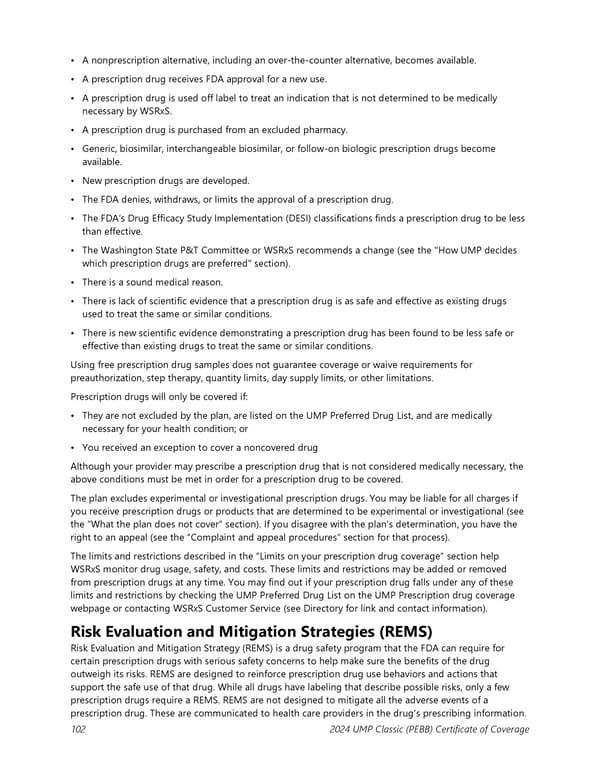• A nonprescription alternative, including an over-the-counter alternative, becomes available. • A prescription drug receives FDA approval for a new use. • A prescription drug is used off label to treat an indication that is not determined to be medically necessary by WSRxS. • A prescription drug is purchased from an excluded pharmacy. • Generic, biosimilar, interchangeable biosimilar, or follow-on biologic prescription drugs become available. • New prescription drugs are developed. • The FDA denies, withdraws, or limits the approval of a prescription drug. • The FDA’s Drug Efficacy Study Implementation (DESI) classifications finds a prescription drug to be less than effective. • The Washington State P&T Committee or WSRxS recommends a change (see the "How UMP decides which prescription drugs are preferred" section). • There is a sound medical reason. • There is lack of scientific evidence that a prescription drug is as safe and effective as existing drugs used to treat the same or similar conditions. • There is new scientific evidence demonstrating a prescription drug has been found to be less safe or effective than existing drugs to treat the same or similar conditions. Using free prescription drug samples does not guarantee coverage or waive requirements for preauthorization, step therapy, quantity limits, day supply limits, or other limitations. Prescription drugs will only be covered if: • They are not excluded by the plan, are listed on the UMP Preferred Drug List, and are medically necessary for your health condition; or • You received an exception to cover a noncovered drug Although your provider may prescribe a prescription drug that is not considered medically necessary, the above conditions must be met in order for a prescription drug to be covered. The plan excludes experimental or investigational prescription drugs. You may be liable for all charges if you receive prescription drugs or products that are determined to be experimental or investigational (see the “What the plan does not cover” section). If you disagree with the plan’s determination, you have the right to an appeal (see the “Complaint and appeal procedures” section for that process). The limits and restrictions described in the “Limits on your prescription drug coverage” section help WSRxS monitor drug usage, safety, and costs. These limits and restrictions may be added or removed from prescription drugs at any time. You may find out if your prescription drug falls under any of these limits and restrictions by checking the UMP Preferred Drug List on the UMP Prescription drug coverage webpage or contacting WSRxS Customer Service (see Directory for link and contact information). Risk Evaluation and Mitigation Strategies (REMS) Risk Evaluation and Mitigation Strategy (REMS) is a drug safety program that the FDA can require for certain prescription drugs with serious safety concerns to help make sure the benefits of the drug outweigh its risks. REMS are designed to reinforce prescription drug use behaviors and actions that support the safe use of that drug. While all drugs have labeling that describe possible risks, only a few prescription drugs require a REMS. REMS are not designed to mitigate all the adverse events of a prescription drug. These are communicated to health care providers in the drug’s prescribing information. 102 2024 UMP Classic (PEBB) Certificate of Coverage
 UMP Classic COC (2024) Page 102 Page 104
UMP Classic COC (2024) Page 102 Page 104